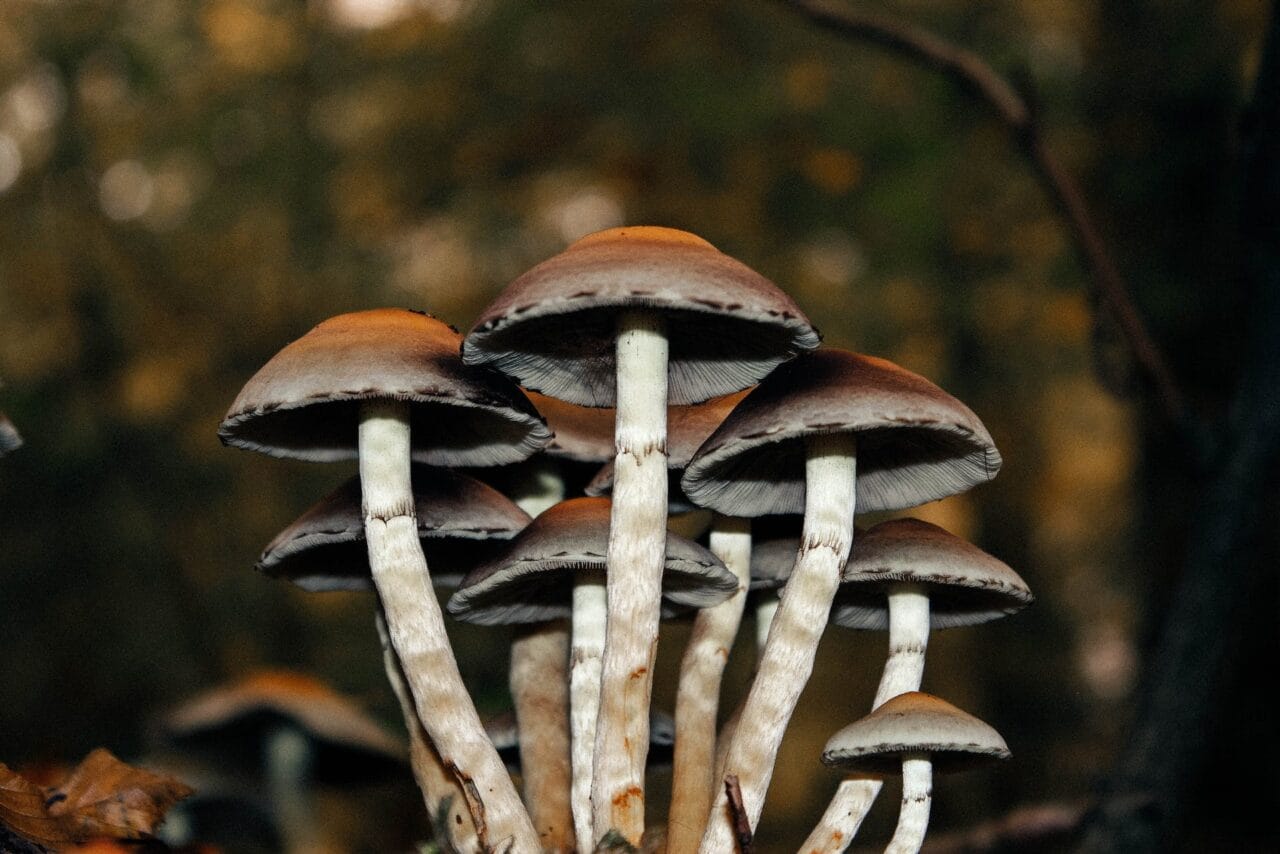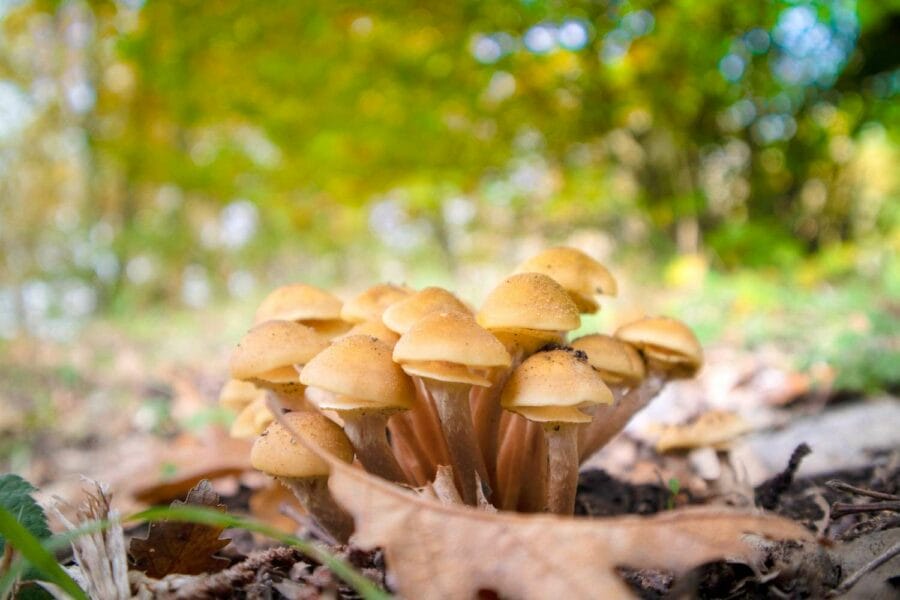Psilocybin, a psychoactive compound found in magic mushrooms, is often consumed recreationally for its euphoria-inducing and hallucinogenic effects.
In addition to its mind-altering properties, research has been conducted into the compound’s potential benefits for relieving chronic pain.
This article examines a case study that explores the potential benefits of microdosing mushrooms in alleviating chronic pain.
Key Takeaways:
- Microdosing mushrooms may provide both immediate and long-term pain relief.
- When compared to traditional pain medications, microdosing psilocybin often has fewer side effects when administered in smaller doses.
- Psilocybin interacts with serotonin 2A (5-HT2A) receptors, which may help alleviate pain among other conditions.

Study Details
Dr. Matthew Lyes and his team from the Division of Pain Medicine in the Department of Anesthesiology at the University of California, San Diego conducted the study titled “Microdosing Psilocybin for Chronic Pain: A Case Series“. They focused their research on three patients who self-administered small doses of psilocybin to manage their chronic pain symptoms.
Three Patients, One Result – Chronic Pain Relief
Patient #1
| AGE/GENDER: | 37, Male |
| TYPE OF PAIN: | Neuropathic pain occurring below the site of a spinal cord injury. |
| PAIN LEVEL: | Initially rated as 4 to 5 out of 10, but increased to 8 out of 10 later in the day |
| PSILOCYBIN DOSE: | 250 mg of ground mushroom for less than 6 months |
| RESULT: | Discontinuation of prescribed pain medication, reduction in muscle spasms, and improved bowel movement efficiency. No signs of rebound pain or withdrawal symptoms were observed. |
| The patient noted that while his usual medications only managed to mitigate the pain, psilocybin effectively eliminated it, reducing his average pain level from 5 to 0. | |
Case Study: Subject #2
| AGE/ SEX: | Female, 69 years old |
| PAIN TYPE: | Complex Regional Pain Syndrome (CRPS) |
| PAIN INTENSITY: | Typically varies from 5 to 7 on a scale of 10, but escalates during physical activity and pain outbreaks |
| PSILOCYBIN DOSE: | Daily dose of 500 mg for one week to ten days with intermittent rest periods (2 to 3 days) over one year. The dose increases to 750 mg to 1 gram during pain outbreaks |
| RESULT: | 80% decrease in pain for 3-4 hours, slowly returning to initial levels after 12 hours. Complete pain relief (90%-100%) lasts for 6-8 hours, returning to initial levels after 18 hours. |
| The subject reports a decrease in appetite without feelings of nausea. Disorientation or unsteady gait is observed when the dose is increased (750 to 1000mg). | |
Case Study: Subject # 3
| AGE/ SEX: | Female, 40 years old |
| PAIN TYPE: | Lumbar radiculopathy and neuropathic pain |
| PAIN INTENSITY: | 8 on a scale of 10, increasing to 10 during physical activities |
| PSILOCYBIN DOSE: | 1000 mg from a chocolate bar containing mushrooms every two months. |
| RESULT: | Significant pain relief without any psychoactive effects. Noticed improvement in flexibility and functionality. Pain gradually reverts to initial levels over a 2-4 week period. Repeated dosing enhances control over pain. |
| The subject does not report any significant physical, cognitive, or behavioural side effects. Her mood remains stable. She continues her regular SSRI dosage for managing depression throughout the psilocybin treatment period. | |
Deciphering Pain Management with Psilocybin
Constant somatic and visceral pain signals strengthen certain neural pathways due to peripheral and central sensitization, resulting in the chronic perception of pain, both physically and emotionally. Psychedelics like psilocybin activate 5-HT2A receptors, potentially resetting the brain areas linked with neuropathic conditions.
A subject reported enduring pain relief for several weeks. This suggests that by directly stimulating the 5-HT2A receptors, there can be a central regulation of pain perception and
The adaptability of synapses.
Possible Adverse Effects of Psilocybin Compared to Traditional Pain Relievers
| PSILOCYBIN (As per Research) | TRADITIONAL PAIN RELIEVERS |
| Muscle spasms | Nausea |
| Decreased appetite | Stomach discomfort |
| Confusion | Migraines |
| Unsteady gait | Addiction |
| No mood changes | Drowsiness |
Prospective Future Research on Psilocybin
After studying the experiences of three individuals, the research team has identified potential research areas that require additional scrutiny due to their potential benefits.
- Small psilocybin doses may provide immediate and potentially prolonged relief from neuropathic pain without leading to physical tolerance or addiction.
- Examine the impacts of different treatment approaches in conjunction with psilocybin. For instance, patient #3 experienced a heightened analgesic effect when psilocybin was combined with physical therapy.
- Small psilocybin doses may provide pain relief even without psychotherapy, as demonstrated in this case study. Incorporating therapeutic guidance could potentially enhance or extend the therapeutic effects.
Constraints of the Study
Despite the encouraging results seen in the patients, it’s crucial to acknowledge the limitations identified in the study.
- The small sample size may not accurately represent the entire population dealing with neuropathic pain.
- The study didn’t include any participants who didn’t respond to psilocybin.
- No assessments were conducted before and after treatment to measure the impact of psilocybin on psychiatric disorders like depression and anxiety.
- Most of the data was self-reported by the participants.
- The interviewer’s presence and potential bias towards psilocybin could have influenced the participants’ responses.
- The study didn’t investigate the influence of the placebo effect.
- The study didn’t ascertain the psilocybin quantity in each mushroom.
Microdosing Psilocybin: An Introduction
In this research, patients #1 and #2 consumed a microdose of psilocybin in powdered form, which was extracted from dried mushrooms. Patient #3, on the other hand, combined it with chocolate. There are several products specifically designed for psilocybin microdosing, and we’ve gathered a few of them below for your convenience.
Dried Psilocybin Mushrooms
The research did not mention the specific strain used, but the following strain can be a great choice for those new to this practice.
- Golden Teacher: This is a widespread and frequently encountered strain of magic mushrooms.
- Amazonian Cubensis: This strain is known for its user-friendliness and cognitive benefits.
- Cambodian: Using this strain for microdosing can improve concentration, social awareness, and mood.
Microdose Capsule Options
- Euphoria Psychedelics – Micro Calm Capsules: This mix contains Ashwagandha, Reishi, CBD, Valerian root, and Psilocybin Mushrooms, all of which have been scientifically shown to alleviate anxiety and stress.
- Ground Sounds – Microdose Capsules – Champion Lover: This appealing blend comes with three dosage choices: 50mg, 100mg, or 250mg of pure psilocybin combined with reishi, cacao, cordyceps, and maca.
- Kind Stranger – Brighten Capsules 250mg: These capsules are filled with the Golden Teacher strain, renowned for promoting clear thinking, enhanced creativity, and increased focus.
Using Psilocybin for Pain Relief
Although the research into the pain-relieving potential of mushrooms is still preliminary, anecdotal reports and small-scale studies suggest promising results.
These instances underscore the importance of more comprehensive research into the possible benefits of psilocybin, class=”wp-block-list”>
Chronic pain management has shown significant improvements, especially with the widespread acceptance of psilocybin as a pain reliever. Encouraging reports from case studies have given hope to those afflicted with persistent pain.
Frequently Asked Questions
What effects does psilocybin microdosing have?
The main effects of psilocybin come from its ability to stimulate a serotonin receptor known as “5-HT2A” located in the prefrontal cortex. This stimulation leads to two key outcomes:
- The generation of “Brain-Derived Neurotrophic Factor” (BDNF)
- Rising levels of “Glutamate” transmission
Moreover, psychedelics foster communication between brain regions that usually don’t interact. This unique connectivity stems from the psychedelics’ ability to lessen the activity of the “Default Mode Network” (DMN), which is associated with various cognitive functions such as introspection, daydreaming, and reflecting on the past and future.
What is the most recognized benefit of microdosing mushrooms?
Microdosing is believed to enhance mood, productivity, creativity, and focus. The most extensively researched benefit is its influence on mental health.
In November 2022, COMPASS Pathways, a company specializing in mental health, disclosed the findings of their comprehensive phase 2b trial – a randomized, double-blind study. Their investigation indicated that a single dose of psilocybin significantly reduced depressive symptoms compared to a placebo. Participants who were administered a higher dose of 25 milligrams showed a lasting antidepressant response at the twelve-week follow-up.
According to a study published in the Psychiatry Research Journal, psilocybin is more effective than traditional antidepressant treatments.
How should you determine your dosage?
Start with a 0.1-gram dose of psilocybin mushrooms on the first day. If you don’t experience the desired effects, gradually increase your dose by 0.05 grams on subsequent microdosing days until you find the level that works best for you.
Those with a history of using psychotropic drugs might need to increase the dose to 0.5 grams to achieve the desired effects.
What precautions should be taken before consuming mushrooms?
- Allocate some time to understand the reasons for microdosing on a specific day.
- Take a moment to analyze and connect with your current emotional or mental state. Recognize the emotions or mindset that you believe will be advantageous for you that day.
- Once your goals are clearly outlined, write them down. Formulating your objectives as affirmations can be a potent strategy to enhance your continuous growth.
- Direct your intention towards the experience you aim to achieve, rather than concentrating on what you want to evade.
- Ingest it on an empty stomach, preferably an hour prior to your first meal of the day.
What is the suggested frequency for taking microdoses of mushrooms?
Several well-regarded protocols recommend structured microdosing schedules for psychedelics. These protocols mainly differ in the number of “off” days they incorporate, which are the days you abstain from microdosing.
The most commonly suggested protocols recommend 1-3 days of rest between microdoses. This aligns with the body’s natural tolerance mechanisms. The three protocols under consideration in this context are the Fadiman Protocol, the Stamets Stack, and intuitive microdosing.




